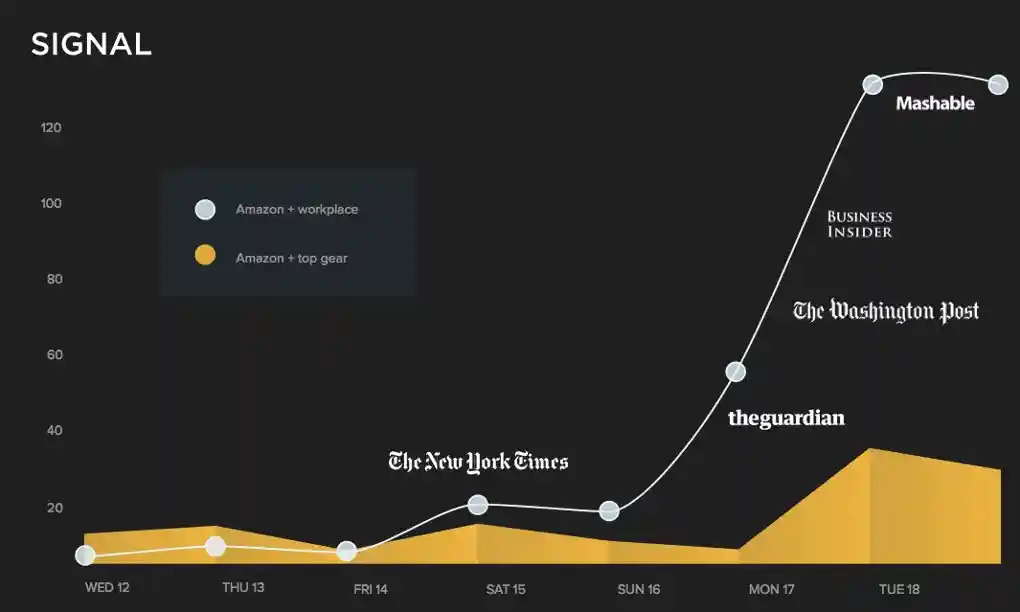Many a business journalist has grown accustomed to being stonewalled by the fabled “no comment” from Amazon’s PR department. That wasn’t the case this weekend, when the company sent its top PR staffer out to bat on US TV, following the New York Times’s expose of the company’s staff culture.
That in itself was an unusual move for a company more used to keeping its mouth shut. But this was an unprecedented story. In a fascinating, 5,400-word report, the NYT took testimony from 100 current and former Amazon employees, who dished the dirt on an aggressive workplace where the desire for success pushed workers to the depths of anguish.
We’ve heard upsetting stories about life in Amazon’s “fulfilment centres” before. But the NYT piece shone a light on why white-collar “amabots” upstairs are driven to make each other’s lives hellish. Still more interesting is what the furore says about the state of modern media.
Stories like this just don’t happen overnight. It’s a huge undertaking to gain trust and interviews with 100 key people. Jodi Kantor and David Streitfeld would have spent months researching, collating, triple-checking and deciding how to tell this story.
That is simply not a luxury you get in today’s fast-moving world of digital journalism, where the pressure on editors to get quick hits is as relentless as Amazon’s thirst for sales. Stories like this demand resource and patience – two things the NYT still has, and for which it is now reaping the reward.
The NYT’s Amazon story has blown up since being published, but this is not just thanks to social media. Just as much as Facebook or Twitter, old-school media reports on radio and TV are the fuel for social discussion. Without them, Twitter and Facebook would be far emptier echo chambers.
Evident in today’s news ecosystem is a pattern of big media influencing big media. Just as consumers went online to respond to the story, so too did other news organisations with their various hot takes. Mashable jumped in with Can you work at an Amazon, Uber or Google and have a life?, the Washington Post (owned by Amazon’s Jeff Bezos) offered the more sceptical Is it really that hard to work at Amazon?, while Business Insider piled in with the contrary Maybe working at Amazon is hard for a reason. When a story like this breaks, modern publishers have learned enough from social distribution dynamics to know that they need a distinct follow-up, and quick.
What’s more damaging to a brand? Online chatter that shows up negative in sentiment analysis, or further negative news articles recommending a boycott of the company, which may spark wider antipathy?
Putting Clarkson in the shade
The controversy around Amazon’s working culture has this week overshadowed a deal supposedly worth £160m. That is the reported amount Amazon Prime is paying to produce a car show starring Top Gear’s former trio of presenters. But data from our media monitoring service, Signal, shows how intended flagship media coverage for that Amazon story this weekend was swamped by the NYT story.

Signal’s research shows how Amazon’s Top Gear announcement was overshadowed by the New York Times piece. Photograph: Signal/PR
On Sunday, the Sunday Telegraph ran an exclusive interview with Bezos. Amazon doubtless intended it as both a flagship feature to talk up TV, and possibly as a spoiler to the expose. But the graph shows how news stories mentioning Amazon and Clarkson were dwarfed by those mentioning Amazon and Bezos, as numerous other publishers jumped aboard with their own reports.
As Flavorwire writes: “Amazon’s brand has been damaged by this NYT article, probably permanently. Many people who used to associate their name with convenience will now be haunted by the knowledge of what that convenience costs.”
Response to brand damage
Online, the NYT story has been met with a healthy dose of “so what?” – at least, from tech company employees used to the industry’s fast pace and high demands.
But you can tell this story has hurt Amazon from the very fact that it is willing to talk to the press.
The company’s senior vice president of global corporate affairs, Jay Carney – previously a White House press secretary, no less – put himself up to field the interview questions on CBS, not all that convincingly, while the company released Bezos’s internal staff email expressing his concerns. So far, however, both are simply saying the claims of 100 staff and one of the world’s most respected newspapers do not make Amazon any different from any other tech firm.
That may be the wrong strategy. Mud sticks, and many consumers will have already heard enough believable negativity around Amazon, from tax avoidance to staff treatment, that the brand already risks damage.
As Poynter’s Benjamin Mullin wrote: “If neither Bezos nor Carney – both of whom have extensive experience working with journalists – aren’t working to correct the story or Amazon’s workplace culture, their public responses amount to a hill of Styrofoam packing peanuts.” At times like these, all the PR efforts in the world can only do so much.